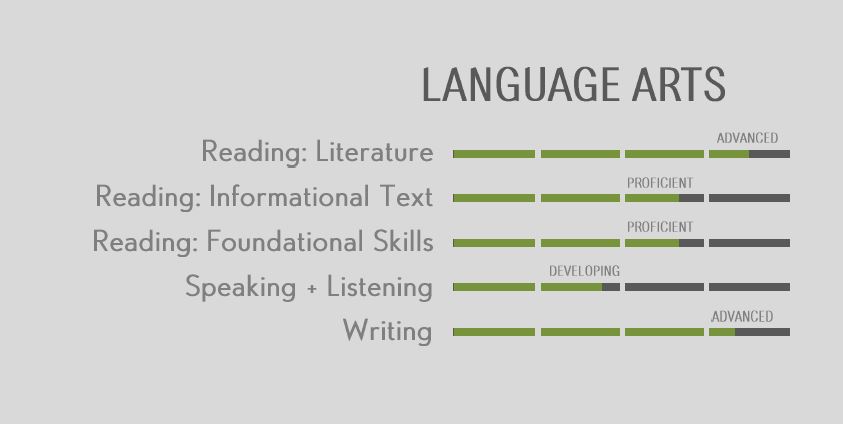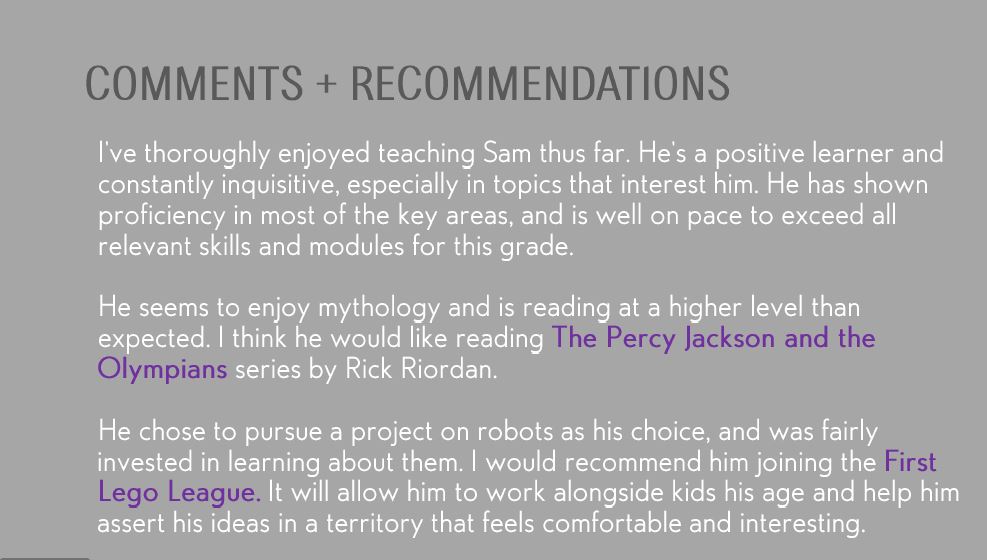Elementary School is the introduction to education, where children not only learn the basic foundational skills of knowledge, but how they approach their own learning and development. One important facet of this system is the report card which communicates the child's academic performance issued by the school to either the student or the student's parents. Many schools across the United States are considering an alternative form of measuring achievement and progress, and while middle and high school records are compelled into standardization for the sake of comparison by universities and other institutions, educators believe it is both viable and necessary for change to occur in elementary schools. After speaking with many administrators across the US, I've put together a brief piece on the state of the old report cards, along with a potential redesign that incorporates methodologies being considered.
Old Report Cards
Sample Elementary School Report Card
The traditional report cards vary in complexity, but generally follow a similar rubric of grading based on performances on evaluation. Each report card covers the core subjects of Language Arts and Mathematics, followed by some level of Sciences, Social Studies, and sometimes the Arts. Each subject is scored by either letters (A-F) or numbers (1-4) for each quarter or semester. Often, the report cards have a small area for the teacher to jot down comments and an area noting attendance and social development. While middle and high school report cards are intended for the students and post-graduate institutions, elementary school report cards are intended for the parents.
Most progressive educators believe that there's a philosophical schism between the values that elementary schools should stand for and the information that report cards provide. First, there is a great focus on Mathematics and Language Arts, and detailed report cards break down elements in both subjects. Science and Social Studies are also considered in most schools, but don't have the same level of detail, and finally the arts, if included, have a different and reductionist evaluation metric like a check mark. While, it's true that mathematics and literacy lay the foundation for learning, the focus in current years has been on evaluation, rather than understanding the relevance of the material. This hierarchy and separation of children based on their abilities in these subjects carries over to their higher education and beyond.
Next, the grading system is based solely on evaluations, instead of mastery, skewing the scale towards the subset of students whose learning abilities align with the pace of the classes. Let's consider two students, one who grasps algebraic concepts quickly and scores highly on all three assessments on the topic during the quarter. The other student however, scores poorly on the first assessment, but improves during the second and third tests. At the end of the quarter, both students have mastered the particular concept, but the second student is given a lower grade on this report card because his test score average was lower than the former student's. This scoring system is built upon stigmatizing mistakes, where a student begins with a set number of points, and with every mistake on tests or exercises, he is docked those points. Students then internalize lack of knowledge as a detrimental quality in themselves, and feel they are inferior to their peers despite having the same level of mastery.
The Redesign
+ Elements from Mathematics and Literacy reflect the Common Core standards, showing the development of the student skills in each category. Instead of a grading system, this report shows student progress in mastering the requisite skills. Additionally, the Module section refers to knowledge-based subjects such as the Sciences and Social Studies that change depending on grade and region.
+ Accompanying this reporting system, we're considering a formative assessment approach based on complexity and accuracy that will award students proficiency points. An "Advanced" level of proficiency will denote the student has surpassed the required grade level for that topic, while a "Proficient" status implies that the student has achieved the grade standard. The other two levels will show topics that the student is struggling with or hasn't had adequate time to master.
+ The idea behind this is two-fold: the student personalizes his learning and views it as a concrete goal to work towards mastering, contrary to the previous method of minimizing errors. The parents can then see their child's development in various areas, and help supplement those areas at home.
+ On the left, the "General Learning Outcomes" section has variability, they can be standardized by the school, or personalized by the student and teacher. The example shows three examples. The first is personalized for the student, where he chose a topic to research that interested him. This could have been replaced by anything from arts to sports. The second example considers a standard value assessment of the student's Teamwork and Communication. Other examples of this would include Leadership, Public Speaking etc. Finally, the last section considers the students proficiency at Computer Literacy, and could be replaced by any relevant skill set required from our culture.
+ These learning outcomes provide parents with a variety of insights regarding their children's strengths and core deficiencies outside of academics. For example, the section on Teamwork and Communication which shows that he struggles with asserting himself which reflects his still developing speaking and listening skill in the Language Arts.
+ The "Comments and Recommendations" section allow teachers to provide a summary for the child's pace and development in the classroom as well as offer personalized advice on books, software, extra-curricular activities, groups etc. that their child may benefit from socially or academically. While objective proficiency levels help parents understand their child's growth in academic areas, the General Learning Outcomes and Comments and Recommendations sections give parents a greater insight into their child's interests, social metrics, and other learning objectives and initiatives.
Final Thoughts
The design is somewhat unrefined and perhaps impractical, but it captures what educators believe would best serve the parents and their children. Ideally, these development metrics would exist online for parents to look up at any time. Many school districts have attempted to distribute new and detailed report cards, but there has been a lot of resistance from local parents. Surprisingly, parents prefer the simplicity of traditional reports, and are most interested in how their students are doing compared to their classmates, instead of their particular level of skill in various areas. Some parents believe that the jargon used in mastery-based reports err on the side of euphemisms like "In Progress", making it vague for them to understand. It's a strange conflict where educators want to get away from comparison and parents want to hold onto it. One Pittsburgh educator claimed that their goal is to compromise and compare performances against standards, providing clarity for the parents, and relevance for teachers. In summary, the most important goal for both parties is the efficient development of the children, and report cards in elementary school are the main source of communication between teachers and parents. A mastery-based grading alongside feedback from teachers regarding non-academic learning resolves both these problems. A future article will consider how to pair formative assessments to rate proficiencies, and then how to deal with differentiation in the classroom.




